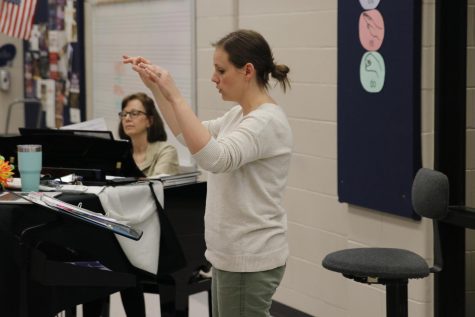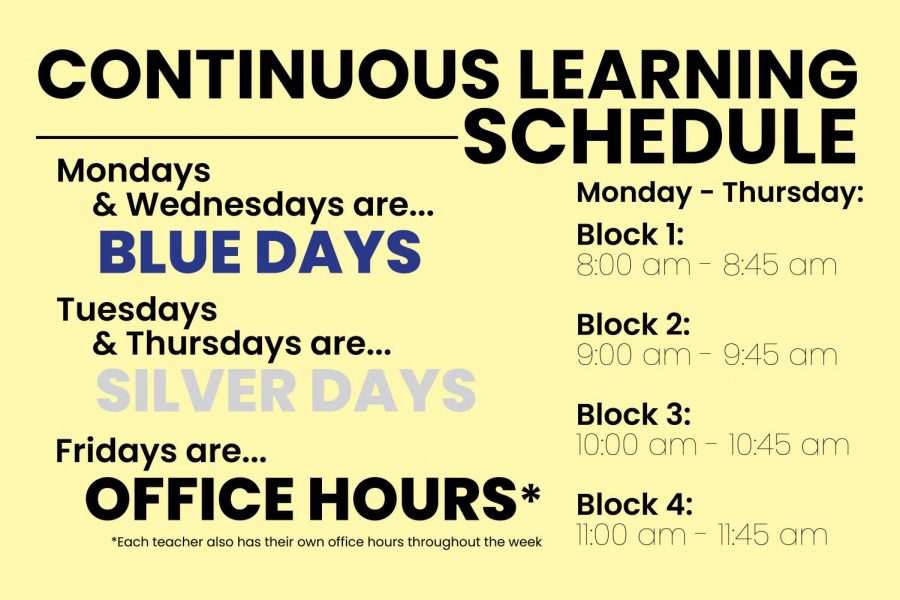District shifts to online learning for remainder of school year
After Kansas Gov. Laura Kelly ordered school buildings to close until Friday, May 29, the district developed a continuous learning plan designed to digitze classrooms
By Hannah Chern
As part of the Continuous Learning Plan, a schedule has been developed to allow students to meet with teachers through virtual meeting applications, such as Zoom, without conflict. While a schedule exists, teachers are not required to conduct mandatory class times during these sessions.
April 7, 2020
On Wednesday, April 1, high school students across the district embarked on an unprecedented continuous learning journey that will last for the remainder of the school year. Tuning into classrooms via applications like Canvas and Zoom, they began the final quarter of a hectic school year marred by COVID-19 school closures.
After Kansas Gov. Laura Kelly announced the mandatory closure of all school buildings through Friday, May 29 on Tuesday, March 17, the Kansas State Department of Education released a series of guidelines for schools to continue teaching while their classrooms remained closed. According to assistant superintendent Alvie Cater, the district assembled a team of educators to rapidly develop a framework for learning at home.
Adapting to the novel digital learning process has been a challenge for students, parents, teachers and administrators alike. In a video sent out to parents and students of all grade levels, superintendent Frank Harwood outlined the core goals of the district’s digital learning platform.
“We are simplifying remote learning by having our teachers at every level focus on essential standards,” Harwood said in the video. “It is better for students to learn a few concepts well instead of covering a lot of material. We are emphasizing that less is more.”
In the video, Harwood also emphasized flexibility as the key to making a rapidly prepared continuous learning plan — online classes began just two weeks after Kansas governor Laura Kelly announced the mandatory shutdown of all school buildings — work for everyone in the district.
High school teachers have taken advantage of this flexibility to implement different continuous learning plans for their classes. According to Cater, high school classes are recommended to assign about 45 minutes of work per day, but it’s up to teachers to decide how to distribute that work.
Teachers of classes where student-teacher interaction is vital, like Spanish teachers Edith Paredes and Jan Good-Bollinger, plan to hold video calls over Zoom for every class period in addition to the work they assign.
Other teachers, such as math teacher Alex Houlton and science teacher Neil McLeod, are not hosting mandatory Zoom meetings during scheduled times of the week, but are instead posting video lectures and requiring students to complete modules and assignments uploaded to Canvas each week.
Junior John Lehan worries that discussion-heavy classes like foreign languages, English and social studies might be especially hard to teach online.
“Language classes rely on speaking practice, so I’m worried online classes may stunt progress significantly,” Lehan said. “Participation-heavy classes could lose the most fundamentally appealing aspect of the class.”
A few teachers, like physics teacher Ryan Johnston, are eschewing their traditional materials altogether. Johnson uses the educational website Khan Academy to assign videos and practice problems for students to complete.
Math teacher Sarah Sides sees the new methods teachers are developing as opportunities for students to learn at their own pace.
“We are covering less material, which allows for more flexibility,” Sides said. “Students have a greater amount of time to master a smaller amount of work. They can also, to a point, work at their own pace.”
For some non-traditional classes, though, the online migration proves especially challenging. Senior Eva Burke worries about how her choir class will continue without the chance to sing and rehearse as a group.
“I have no idea how we’re going to do choir online, and I’m not looking forward to trying,” Burke said.
When she first found out that she needed to move her classroom online, choir teacher Jessie Reimer felt the same way.

Choir teacher Jessie Reimer conducts a song during class Wednesday, March 11. With the district’s migration to online learning, Reimer has had to find new ways to teach choir without the opportunity to sing as a group. “We are all embracing the challenge and finding ways to create meaningful learning experiences for our students,” Reimer said.
“Obviously, the largest and most enjoyable component of choir is singing and interacting as a group,” Reimer said. “Online learning makes this nearly impossible unless you have the best technology and even then, it’s completely different.“
Reimer eventually decided to focus her class on individual at-home exercises like sight-reading practice and music theory lessons, although her classes do still hold weekly face-to-face meetings via Zoom. While she knows how disappointed many teachers were with the new challenge they’d be facing, she believes that they’re all trying to manage it as best as possible.
“Other teachers, especially those in the performing arts department whose fourth quarter performances had to be canceled, have had similar reactions of sadness,” Reimer said. “However, we are all embracing the challenge and finding ways to create meaningful learning experiences for our students.”
Just as teachers had to find ways to digitize their classrooms, students have also been required to find new ways to adapt and manage school. Lehan believes that the online learning system gives high schoolers a unique opportunity to make the best of a bad situation.
“It’s not negotiable, so I’ve tried to focus on the positives,” Lehan said. “Normally, high schoolers don’t have flexibility and responsibility managing their day. Online coursework gives students a chance to capitalize on this new environment.”
Burke is also grateful for the plan, although she believes that the social aspects of in-person classes are impossible to repeat online.
“I’m glad that we have the continuous learning plan instead of nothing at all,” Burke said. “I think we can do a lot of things online, but we’ll miss out on the social interactions between and during class that can’t really be replicated online.”
Grades are the only part of the continuous learning plan yet to be finalized. In nearby districts like Blue Valley, student grades cannot drop as a result of their fourth quarter performance during online learning; however, the district is yet to make a final decision on grading policy.
According to a statement on the district website, “expectations for fourth quarter grade requirements, documentation and recording are still being determined.”
The lack of a grading policy echoes Lehan’s one criticism of online learning: he thinks that while the policies have been good, their implementation has been confusing.
“Although a necessary adjustment to the pandemic, the continuous learning plan’s rollout has been unorganized and inefficient,” Lehan said. “Even now, information comes slowly. Students can’t adjust to the changes without a clear plan, but the slow rollout has allowed rumors to take over.”
On the other hand, Cater sees the development of a continuous learning plan as the product of successful cooperation and collaboration across the district.
“This undertaking has been a whole team effort and is a testament to the passion and expertise of our staff,” Cater said.
During an unprecedented time for students, teachers, administrators and parents, Sides wants everyone in the district to be forgiving and flexible.
“I want students to know that we are all in this together. There’s going to be a huge learning curve for all of us, and we (as teachers) are probably going to make mistakes,” Sides said. “Give yourself some grace; we’re doing the same thing!”














